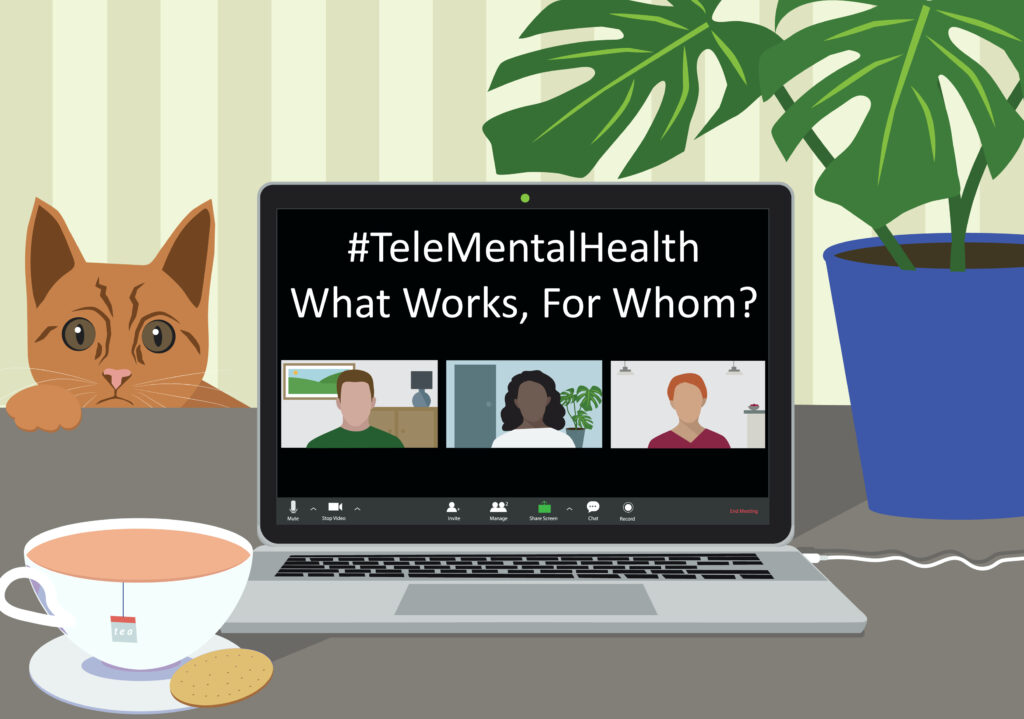
The COVID-19 pandemic has forced mental health providers to move their therapies online. Remotely-delivered therapy has been around since the 1990s, but this has never reached the mainstream as much as in-person care, despite its obvious benefits, such as increased accessibility and cost-effectiveness.
COVID-19 poses a continuous challenge to the way we deliver mental health interventions, resulting in an ongoing need for face-to-face intervention alternatives. To ensure therapeutic methods are as effective as in-person therapy, it is imperative that implementation of telemental health is evaluated.
This blog will discuss a rapid umbrella review of reviews by Barnett et al. (2021), who summarised the existing literature on implementation of telemental health services, to better understand any challenges of remote-delivery. More specifically, the aspects they focused on included not only effectiveness, but also additional factors relevant for treatment outcome such as acceptability, treatment adherence and the therapeutic relationship.

Thanks to the Covid-19 pandemic, telemental health is here to stay.
Methods
To identify systematic reviews that were pertinent to the topic, Barnett et al (2021) used a search strategy comprising three elements, with a large variety of keywords representing 1) type of study/reviews; 2) disorders; and 3) remote delivery of therapy. The search was carried out across three widely used databases in this topic area.
To be included the systematic review had to meet the following criteria; include staff working within the field of mental health, include any form of spoken or written communication between mental health professionals and patients, service users, family members, carers or other mental health professionals. The authors included systematic reviews with or without meta-analyses, realist reviews, and qualitative meta-syntheses.
Records were independently screened, with 10% being discussed to reach agreement between two raters, and full-text articles reviewed by five raters.
Widely-accepted guidelines were used for the literature screening process (PRISMA) and for quality rating of the articles (AMSTAR 2).
Results
The search resulted in 292 potentially relevant articles, after a full-text check, 19 of the reviews met the inclusion criteria and were selected for the review. The number of articles included in each of the reviews ranged from 9 to 41. The quality of the studies was rated as low for the majority of the studies.
The reviews were assessed on the following sub-categories: clinical objectives, implementation objectives and acceptability objectives.
Clinical objectives
Across the selected reviews and a range of mental health conditions, the authors found that telemental health assessments and interventions produce at least a moderate decrease in symptom severity. Videoconferencing interventions in particular were shown to be effective, with multiple reviews suggesting it’s comparability to face-to-face interventions at the end of treatment. When it comes to longer-term effects, results were promising but have been mixed, and more longitudinal research is required to draw firm conclusions.
Implementation objectives
Treatment fidelity and therapist competence seemed adequate and were at similar levels for video-conferencing compared to in-person treatments. Treatment adherence and drop-out rates did not differ when comparing remotely-delivered sessions versus in-person therapy. Furthermore, comprehension of tasks and completion for phone and video sessions were found to be good. Technological issues such as connectivity problems or low image resolution were not perceived as a barrier by patients, but some patients may value mobile-based therapy over video-conferencing. Telemental heath was deemed cost-effective compared to in-person treatment, both for the service provider (e.g. in rural communities) and for the patient (less travel costs; less time to take off work). Long-term costs expressed as health service utilisation after treatment appear similar for in-person and remote therapy.
Acceptability objectives
The study results showed that telemental health is deemed acceptable by older adults. Some clinicians may prefer in-person over remote assessment and treatment, though they are deemed acceptable and practical benefits are recognised. Some professionals were reported to worry that they would miss some non-verbal ‘cues’. Patient satisfaction in general was high for both remote and in-person therapy across a range of symptomatology and patient samples, even for those who had not previously used video conferencing. The convenience of having sessions from home was also recognised by patients. Some clinicians were reported to fear the sessions were less personal, however this was not backed up by evidence as the therapeutic alliance was deemed as satisfactory; in-person sessions and satisfaction of the therapeutic relationship may be deemed even higher by patients than by therapists.

Telemental health interventions were found to produce at least a moderate decrease in symptom severity across a range of mental health problems.
Conclusions
Telemental health (especially videoconferencing) is as effective and acceptable as in-person therapy. Individual preference may differ, though the convenience of remote therapy is generally recognised. Some therapists may have concerns about this modality, especially when it comes to the therapeutic relationship and picking up on nonverbal cues but these concerns are not shared by patients.

Whereas clinical practitioners may worry about effectiveness and the therapeutic relationship of remotely-delivered therapy, treatments are effective and patients are satisfied.
Strengths and limitations
- Because of the nature of a review of reviews, specificities of findings in the original articles may have gotten lost.
- The low-quality ratings of the reviews were mostly due to lack of methodology information but it is not clear how this would have impacted interpretability or validity of the studies.
- Though the reviews showed effectiveness of therapy, longitudinal research is needed to determine effects over time.
- No studies included individuals receiving both in-person and telemental health treatments; experiencing both styles of interventions may have added to the accuracy of results on comparison of the different conditions.
- Cultural adaptation of telemental health was not covered in the review, however this may be a relevant recent area of research and some studies may be ongoing (e.g. Spanhel et al., 2020)

Due to this being a review of reviews, some of the nuances of findings in the original articles may have been lost.
Implications for practice
Telemental health has huge advantages for accessibility to a wide audience. This form of therapy may be able to reach historically underserved groups (Dwyer et al., 2021) and make treatment available for individuals who have very remote workplaces (Brown et al., 2019).
Education about technology and telemental health is important – not just for the client, but also the referral network. General Practitioners can act as gatekeeper towards referrals for telemental health, and may experience their own barriers for referring (Tizler et al., 2020). Merchant (2021) pointed out that it is important for practitioners to be aware of their own biases towards (or against!) the use of technology in treatment, promoting self-awareness. The frustration of the therapist with technology may be unintentionally shared with the client and it is important to keep this from impacting practice (e.g. focus, fidelity, agenda).
Safeguarding and risk
Ensuring safety is a key (ethical) issue in working remotely (e.g. Merchant, 2021; Stoll et al., 2021). Identifying and verbalising any ambiguity in (non-verbal) communication as well as clarifying questions may help mitigate this disadvantage and ensure safety.
The different therapeutic process needs consideration in light of risk, as for example the transition from a click of the button to end a session, to the patient’s routine activities is different. When a client ends an in-person session, there are more physical and mental steps involved to leave the session. To mitigate any risks arising from the context of remotely-delivered therapy, unambiguous risk management policies should therefore be in place (drawn up collaboratively with the client), including what to do when a connection breaks up during a session and the client cannot be reached.
The therapeutic relationship
In a review of case-studies using a psychoanalytic perspective, Merchant (2021) wrote about the challenges and advantages of telemental health during the Covid-19 pandemic, and argued that transference and countertransference can take place online in a ‘good enough’ form. They concluded that the therapeutic relationship can flourish online, the most important ingredient being the tailoring of the therapy to the individual client.
It has been recommended that the therapist, when working with videoconferencing, should make sure they can see themselves online, so they can adjust their non-verbal communication (Merchant, 2021), for example, to make sure their expressions are in accordance with what they wish to communicate to the client.
Final comments
Telemental health and the format that is used for its delivery should be adapted to suit the client’s needs and therapists should inform themselves about the population they work with and any barriers to access that may arise. Tailoring treatments to client’s preferences helps with engaging and improves outcomes for internet-delivered therapy (Mukhiya et al., 2020). Besides tailoring treatments to specific mental health symptoms, therapists can adapt their online practice by adjusting content and design, and adding elements such as feedback messages and communication about interventions (Mukhiya et al., 2020).

Telemental health interventions should ultimately be adapted to suit the client’s needs to ensure improved engagement and outcomes for clients.
#TeleMentalHealth: What Works, For Whom? Webinar – 22nd March 2022
The NIHR Mental Health Policy Research Unit and The Mental Elf are organising a free webinar that will take place at 2-5pm GMT on Tuesday 22nd March 2022.
The webinar will focus on the policy context of implementing telemental health care in services, as well as how best to address the challenges of conducting and accessing telemental health care.
Statement of interests
None.
Links
Primary paper
Barnett, P., Goulding, L., Casetta, C., Jordan, H., Sheridan-Rains, L., Steare, T., … & Johnson, S. (2021). Implementation of Telemental Health Services Before COVID-19: Rapid umbrella review of systematic reviews. Journal of medical Internet research, 23(7), e26492.
Other references
Brown, S. P., Davis, H. E., McGladrey, L., Brooks, L., Lorentzen, A. K., Penninga, L., Davis, C., & Lemery, J. (2020). Psychological Care Augmented by Telemedicine after a Polar Bear Encounter at an Arctic Research Station: A Case Report. Telemedicine journal and e-health : the official journal of the American Telemedicine Association, 26(3), 369–373.
Dwyer, A., de Almeida Neto, A., Estival, D., Li, W., Lam-Cassettari, C., & Antoniou, M. (2021). Suitability of Text-Based Communications for the Delivery of Psychological Therapeutic Services to Rural and Remote Communities: Scoping Review. JMIR mental health, 8(2), e19478.
Merchant J. (2021). Working online due to the COVID-19 pandemic: a research and literature review. The Journal of analytical psychology, 66(3), 484–505.
Mukhiya, S. K., Wake, J. D., Inal, Y., Pun, K. I., & Lamo, Y. (2020). Adaptive Elements in Internet-Delivered Psychological Treatment Systems: Systematic Review. Journal of medical Internet research, 22(11), e21066.
Spanhel, K., Balci, S., Baumeister, H., Bengel, J., & Sander, L. B. (2020). Cultural adaptation of Internet- and mobile-based interventions for mental disorders: a systematic review protocol. Systematic reviews, 9(1), 207.
Stoll, J., Müller, J. A., & Trachsel, M. (2020). Ethical Issues in Online Psychotherapy: A Narrative Review. Frontiers in psychiatry, 10, 993.
Photo credits
- Photo by Annie Spratt on Unsplash
- Photo by Sarah Kilian on Unsplash
- Photo by Usman Yousaf on Unsplash
- Photo by Zach Vessels on Unsplash
- Photo by Ricardo Resende on Unsplash
- Photo by LinkedIn Sales Solutions on Unsplash

